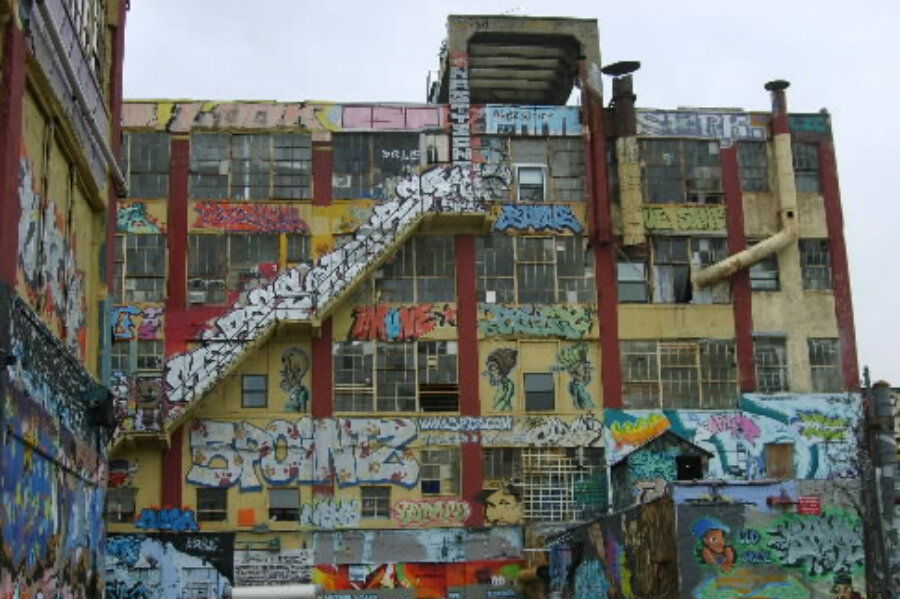5 Pointz down: NYC demolishes storied graffiti shrine
Loading...
| NEW YORK
It has been decades since the underground art of graffiti went mainstream, giving some of its renegade aerosol painters a Picasso-like worldwide fame.
And for the past 20 years, the mecca of the gritty urban art form had been 5 Pointz, a dilapidated, graffiti-covered old factory complex in Queens, world renowned as a work space and urban exhibit in one, and defiantly dubbed "The Institute of Higher Burnin'."
Though 5 Pointz had already been shuttered last year to make way for a new complex of gleaming residential high-rises, last week developers finally brought the wrecking ball to the global graffiti shrine, seen every day by thousands of commuters on the elevated 7 train as it rumbled just yards away every 10 minutes or so.
Yet as the final requiems for 5 Pointz echo in New York this week, the celebration of the more creative aspects of what most consider vandalism or neighborhood blight continues in many of the city’s more highbrow venues. At the Museum of the City of New York, part of the famous “Museum Mile” on Fifth Avenue in Manhattan, the exhibit “City as Canvas” is showing a selection of graffiti art through September.
“Graffiti art is now widely admired, but many questioned its merits during the movement’s development in the 1970s,” said Susan Henshaw Jones, the museum’s director, in a statement. “Understanding the importance of graffiti as an urban statement, the City Museum embraced the opportunity to acquire this collection, which included many works by artists living just blocks away.”
But graffiti’s wide admiration in some quarters is angrily denounced in others, of course. One reason is that NYC pioneered the notion that the proliferation of graffiti encourages crime.
"I find it outrageous that one of the city's museums is currently celebrating graffiti and what a great impact it had on the city," said New York Police Commissioner William Bratton, whose hallmark “broken windows” theory of policing makes a special effort to scrub graffiti from the urban landscape and arrest the bandana-clad vandals making a name with their spray-paint craft.
The commissioner, who helped put a halt to the city’s infamous graffiti-covered subway cars of the 1970s and ’80s during his first tenure as NYC’s top cop, objected to "having New York City school kids at the impressionable age of 12 years old walking through looking at this stuff and having it advertised as, 'Isn't this great?' " he said last week, according to The Wall Street Journal.
But 5 Pointz began in 1993 as the “Phun Phactory,” an effort to discourage graffiti vandalism and create a more mainline showcase for a form created by the urban poor, who rarely get such opportunities. In 2002, Jonathan Cohen, a spray-paint artist known as Meres One from the Flushing neighborhood of Queens, began to curate the work and develop the space into a kind of urban art colony as graffiti began to achieve acceptance from the global art community.
Artists such as Jean Michele Basquiat, who rose to international fame working with a graffiti crew in the Lower East Side in Manhattan in the late 1970s and ’80s, helped bring high-brow attention to the visual representations of the urban poor before his death of heroin overdose in 1988.
The Whitney Museum of American Art, another “Museum Mile” venue, did a retrospective of his work in 1992, and in 1996, Miramax Films released the biographical movie “Basquiat,” starring Jeffrey Wright, David Bowie, and Dennis Hopper, among other A-list names.
And today the pseudonymous Banksy, based out the United Kingdom, is one of the most well-known current artists in any medium. Last October, the secretive artist, whose identity has never been revealed, did a self-described one-month “residency” in New York, called “Better Out than In.” Posting his politically charged exploits on a website, Banksy worked the city with his graffiti art, and thousands of New Yorkers – including some of the private owners of properties where his work appeared – anticipated and celebrated each appearance of a new piece.
Banksy’s 2013 “residency,” however, did not please then-Mayor Michael Bloomberg, who donates millions himself to the arts, and the NYPD’s vandalism unit was on the hunt for the graffiti legend.
“Graffiti does ruin people’s property and is a sign of decay and a loss of control,” former Mayor Bloomberg said at the time. “Art is art, and nobody’s a bigger supporter of the arts than I am. I just think there are some places for art, and there are some places [for] no art. And you running up to someone’s property or public property and defacing it is not my definition of art.”
But going mainstream has its mainstream risks, and the building's owners, father and son team Gerald and David Wolkoff, really had no choice but to develop the valuable site. The 200,000 square-foot structure rested in Long Island City, a fast-developing neighborhood just across the East River, and where other new apartment towers, each with spectacular views of the Manhattan skyline, have been rising up the past few years.
The Wolkoffs rankled the New York art community last November when, in the cover of night, they whitewashed 5 Pointz’s storied walls of graffiti. "I did it like a Band-Aid – in one shot, right off," Gerald Wolkoff said at the time.
The new residential towers include plans for 12,000 square feet of art space, and 10,000 square feet of external panels on the site devoted to aerosol art.
“You must understand I love what they did,” Mr. Wolkoff told New York Magazine last year, after the building’s whitewash. “I didn't like it, I love what they did.... I've got two high-rise rental apartment buildings – a 47- and a 41-story building. I'll have 60-foot walls for them to come in and express themselves.”








